Technisches Hilfswerk
The Bundesanstalt Technisches Hilfswerk (THW, Federal Agency for Technical Relief) is a civil protection organisation controlled by the German federal government. 99% of its 79,543 members (2019) are volunteers.[2]
| Bundesanstalt Technisches Hilfswerk (THW) | |
 Federal sign of the THW | |
 Main logo of the THW | |
| Agency overview | |
|---|---|
| Formed | August 22, 1950 |
| Preceding agency | |
| Jurisdiction | Federal Ministry of the Interior (Germany) |
| Headquarters | Bonn-Lengsdorf |
| Employees | 1,800[1]; 79,543 volunteers[2] |
| Annual budget | EUR 314,239,000 (2020)[3] |
| Agency executives |
|
| Parent agency | Federal Ministry of the Interior (Germany) |
| Child agencies |
|
| Website | www.thw.de |
Tasks
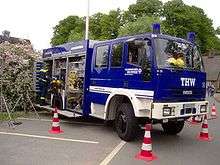
The tasks of the THW are described in a law called THW-Gesetz.[4] These tasks are:
- technical and logistical support for other (German) GOs, NGOs or other authorities like fire brigades, police or the custom authorities
- technical or humanitarian relief in foreign countries, as assigned by the government
- technical relief in Germany as part of national civil protection measures.
History
After World War II the Technisches Hilfswerk was founded in 1950, by order of the minister of the interior. The first president of the THW was Otto Lummitzsch, who had founded the THW's predecessor, the Technische Nothilfe, in 1919. The main purpose of the THW was civil defense in the event of war. This has changed during the decades; today the THW is a helper in a wide spectrum of disasters, such as traffic accidents, industrial disasters, or earthquakes.
The largest disaster control action took place in August 2002 after the flooding of the Elbe river in eastern Germany. About 24,000 THW members participated in the operation, with up to 10,000 people helping simultaneously along the Elbe and its tributaries.[5][6]
The largest engagement outside Germany was in France in 2000, after storms Lothar and Martin had destroyed much of the overhead electrical overland wires and overturned trees blocked many streets from December 26 to 28, 1999. The main contribution was supplying temporary electrical power for hospitals and other important institutions and rebuilding parts of the electrical system.
The organisation has also been active in many disaster relief operations abroad, for example after the 2004 Indian Ocean earthquake (for both relief operations and medium-term rebuilding), Hurricane Katrina in 2005, the 2005 Kashmir earthquake,[7] in 2010 during the flooding in Poland, the 2011 Tōhoku earthquake and tsunami.[8], the April 2015 Nepal earthquake and the 2020 Beirut explosions.
Organization
As a federal authority which is part of the Federal Ministry of the Interior, the THW is headed by the president of the THW administration together with its board. The headquarters of the THW administration and management (THW-Leitung) are in Bonn-Lengsdorf, together with the Bundesamt für Bevölkerungsschutz und Katastrophenhilfe (BBK) (Federal Office for Civil Protection and Disaster Assistance).
The THW comprises 668 THW local chapters, 66 regional offices, 8 state associations, and the THW administration in Bonn, which is subject to the THW President and assists him in his daily official business. It consists of the management staff, the commissioner of volunteers, and the Deployment Section with the units E1 mission, E2 foreign, E3 training, E4 logistics, and E5 technology, and the Central Services Section with the units Z1 helpers and staff, Z2 organization, Z3 finance, Z4 security and health protection, and Z5 information and communication.
The THW logistics center has its office in Heiligenhaus, and is, via its attachment to the Logistics Unit E4, part of the THW administration.
Field organization
Organization in Germany
The THW is stationed all over Germany in 668 local chapters, called Ortsverbände (OV). Some 80,000 people are active in this organisation including about 15,000 young volunteers (members of the THW Youth). The majority of those are volunteers, while about 1,800 work full-time in its administration.[1] Each local chapter (Ortsverband) maintains one or more Technische Züge (technical platoons), each consisting of one Zugtrupp (command squad), comprising four volunteers, one Bergungsgruppe (rescue units) comprising nine to twelve volunteers, and one to three Fachgruppen (technical units), comprising four to eighteen volunteers.
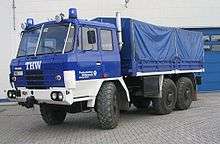

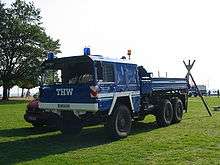
The main type of THW unit is one of two Bergungsgruppen (1st and 2nd Rescue Groups), equipped with heavy tools like hydraulic cutting devices, chain saws, and pneumatic hammers. Their vehicles are the Gerätekraftwagen 1 (GKW 1) (Equipment Truck 1) for the 1st Rescue Group and the Mehrzweckkraftwagen (MzKW) (Multi-Purpose Truck) or the older Gerätekraftwagen 2 (GKW 2) — which is scheduled to be phased out — for the 2nd Rescue Group.
The Fachgruppen (Technical Units) include:
- Bridge Building (Brückenbau)
- Debris Clearance (Räumen)
- Demolition/Blasting (Sprengen)
- Electricity Supply (Elektroversorgung)
- Emergency Supply and Maintenance, (Notinstandsetzung & Notversorgung, introduced 2019 as a replacement for the former technical unit Illumination and many 2nd rescue units)
- Infrastructure (Infrastruktur)
- Oil Pollution (Ölschaden)
- Search and Rescue (Ortung)
- Water Damage / Pumping (Wasserschaden / Pumpen)
- Water Hazards (Wassergefahren)
- Water Supply and Treatment (Trinkwasserversorgung)
Furthermore, two types of technical units exist outside of technical platoons. They provide support mainly during major incidents or multi-regional operations:
- Logistics (Logistik)
- Command, Control and Communications (Führung und Kommunikation)
International Deployment
For relief in foreign countries, there are four Schnelleinsatzeinheiten Bergung Ausland or SEEBA (Rapid Deployment Unit Search and Rescue Abroad) units according to INSARAG standards, able to go airborne within six hours[9], and three Schnelleinsatzeinheiten Wasserversorgung Ausland or SEEWA (Rapid Deployment Unit Water Supply and Treatment Abroad) units.
The THW also operates High capacity Pumping (HCP) modules for the EU Civil Protection Mechanism.
Furthermore, the THW has a pool of experts which can be rapidly deployed to places of crisis to perform assessment and coordination tasks within the fields of technical and logistical support. Those experts are also active in capacity building operations.
Services provided
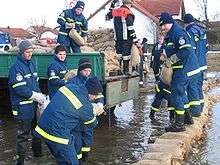
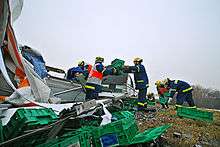
Technical threat prevention
- Area lighting
- Clearing and blasting
- Combating flooding and inundation
- Search and rescue, and salvage
- Water rescue
Infrastructure technical support
- Electricity supply
- Emergency bridge work
- Drinking water supply
- Waste water disposal
Command and communication, logistics
- Catering and care of operational staff
- Command center establishment and operation
- Command support
- Creation of temporary telecommunication systems
- Establishment and operation of logistical bases
- Maintenance of material, repair and maintenance work for mission equipment
- Transportation of consumer goods for mission demands
Technical support in the protection of the environment
- Fighting against oil damage
- Water analysis
Provision of the population
- Electricity and drinking water provision
- Establishment and equipment of emergency accommodation and collecting points with matching infrastructure
- Waste water disposal
Technical support
- Diving
- Makeshift road works
- Maintenance of civil protection facilities such as emergency wells and shelters
- Rescue from heights
- Technical help on traffic routes
Personnel
In Germany, military service was mandatory for adult males until 2011. Instead of joining the military for six months full-time, one of the alternatives was to join a non-combatant volunteer organisation within the German Katastrophenschutz (disaster relief) or Zivilschutz (civil defense) for a minimum of four years (this is calculated so that although serving far less time every week, in the end the number of served hours was about the same). The THW was one of those organisations. Others were too, such as volunteer fire brigades and various organisations engaged in emergency medical service; however, the THW relied more heavily on such quasi-conscripts, as it tends to have less local popularity than, e. g., volunteer fire brigades (who tend to be the chief social club of their respective village or town-quarter), and as it had less of an infrastructure of paid employees than, for instance, the German Red Cross.
The THW has its own decoration for meritorious service or exemplary achievements in the field of emergency management or civil protection: All three classes of the Ehrenzeichen des Technischen Hilfswerks are approved by the President of Germany.
Ranks
In general, the rank structure of the THW is divided into two groups: the volunteers and the full-time employees.
Volunteers
| Chapters | ||||||||||
|---|---|---|---|---|---|---|---|---|---|---|
| Head of Local Branch (Ortsbeauftragter) |
Deputy Head of Local Branch (Stv. Ortsbeauftragter) |
Training and Qualification Officer (Ausbildungsbeauftragter) Expert Advisor (Fachberater) |
Youth Activity Leader (Jugendbetreuer) Maintenance Sergeant (Schirrmeister) Public Relations and Volunteers Recruitment Officer (Beauftragter für Öffentlichkeitsarbeit) Administration Secretary (Verwaltungsbeauftragter) Cook (Koch) | |||||||
| Technical Platoons & Technical Units | ||||||||||
|---|---|---|---|---|---|---|---|---|---|---|
| Technical Platoon Leader (Zugführer) Team Leader Logistics Unit(Leiter der Fachgruppe Logistik) Team Leader Command and Communications (Leiter der Fachgruppe Führung/Kommunikation) |
Command Squad Leader (Zugtruppführer) Command Department Head (Sachgebietsleiter der Fachgruppe Führung/Kommunikation) |
Group Leader (Gruppenführer) |
Squad Leader (Truppführer) Command Assistant (Führungsgehilfe) |
Helper (Helfer) | ||||||
| Spokespersons and Representatives | ||||||||||
|---|---|---|---|---|---|---|---|---|---|---|
| Federal Spokesperson (Bundessprecher) |
Deputy Federal Spokesperson (Stv. Bundessprecher) |
State Spokesperson (Landessprecher) |
Deputy State Spokesperson (Stv. Landessprecher) |
Local Spokesperson (Helfersprecher) Deputy Local Spokesperson (Stv. Helfersprecher ) |
Representative, Federal Association (Vertreter Bundesvereinigung) Representative, State Association (Vertreter Landesvereinigung) | |||||
Full-time employees
| President (Präsident) |
Vice President (Vizepräsident) |
State Commissioner (Landesbeauftragter) Headmaster of the Federal Academy (Leiter der Bundesschule) Division Chief (Abteilungsleiter) Commissioner of Volunteers (Beauftragter für das Ehrenamt) |
Department Chief (Referatsleiter) Academy Manager (Schulmanager) Chief of the Management Staff (Leiter des Leitungsstabes) |
Department Consultant (Referent) |
|---|---|---|---|---|
| Regional Office Chief (Regionalstellenleiter) |
Senior Consultant (Sachbearbeiter) Specialist Teacher (Fachlehrer) |
Service Consultant (Bürosachbearbeiter Service) Instructor (Ausbilder) Artisan (Gerätehandwerker) Driver (Kraftfahrer) |
Consultant (Bürosachbearbeiter) Trainee (Auszubildender) Federal Service Volunteer (Absolvent Bundesfreiwilligendienst) Social Service Volunteer (Absolvent Freiwilliges Soziales Jahr) Intern (Praktikant) |
|---|---|---|---|
Heads of THW
- 1952–1955: Otto Lummitzsch
- 1955–1958: Alexander Löfken
- 1958–1962: Rudolf Schmidt
- 1962–1977: Hans Zielinski
- 1977–1985: Hermann Ahrens
- 1985/1986: Helmut Meier
- 1986–2002: Gerd Jürgen Henkel
- 2002–2006: Georg Thiel
- 2006-2020: Albrecht Broemme
- since 2020: Gerd Friedsam
THW-Jugend
The THW-Jugend (THW Youth) is the youth organization of the THW. It has set itself the target to introduce boys and girls from the age of six in a playful way to the work of the THWs. The THW-Jugend is not part of the Federal Agency for Technical Relief, but is an independently registered charity. This arrangement was made in order to avoid maintaining a state youth organization.
See also
- Civil defense or Civil defense by country
- State Emergency Service — a similar organization in Australia
References
- "Die Bundesanstalt Technisches Hilfswerk im Überblick" (PDF). www.thw.de (in German). THW. Retrieved 11 July 2020.
- "Annual Report 2019" (PDF). THW. Retrieved July 10, 2020.
- "Budget THW 2020". www.bundeshaushalt.de (in German). Federal Ministry of Finance. Retrieved 2020-07-11.
- "THW-Gesetz - Gesetz ueber das Technische Hilfswerk". Retrieved 2010-10-17.
- "Flutkatastrophe 2002: Wasser, soweit das Auge reichte". www.thw.de. Retrieved 2020-07-11.
- "Rund 10.000 THW-Helfer im Einsatz". www.thw.de. Retrieved 2020-07-11.
- "Technical and Humanitarian Assistance Worldwide". Archived from the original on 2007-05-04. Retrieved 2008-04-29.
- "Erdbeben in Japan: THW setzt Hilfe fort". Retrieved 2011-03-14.
- "The SEEBA Special Unit – the Government's Tool to Help Rescue and Salvage Operations Domestically and Abroad". Retrieved 2008-02-17.
External links
| Wikimedia Commons has media related to Technisches Hilfswerk. |